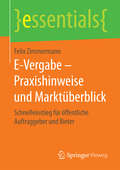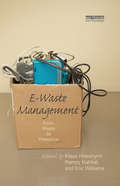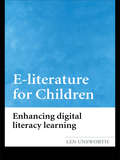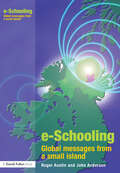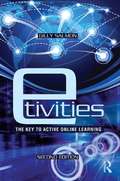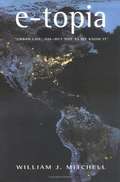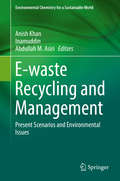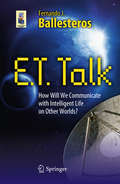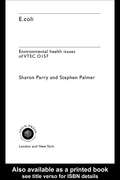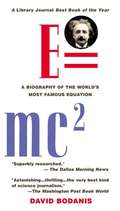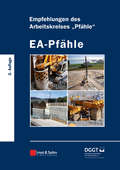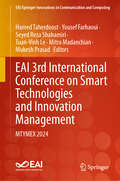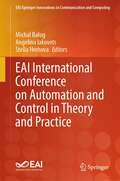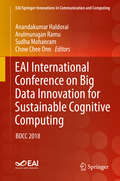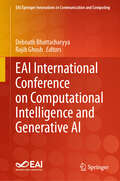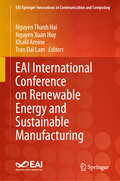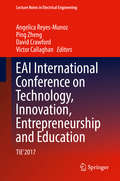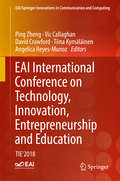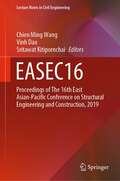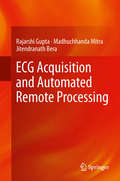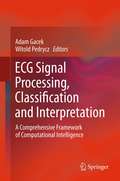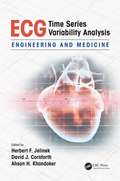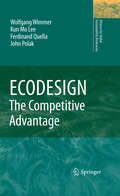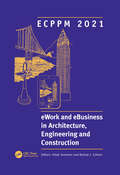- Table View
- List View
E-Sports: The Fastest-Growing Sport in the World / A New Threat (Fountas & Pinnell Classroom, Guided Reading)
by Carmen Morais Ricardo Santos Red DressNIMAC-sourced textbook
E-Vergabe – Praxishinweise und Marktüberblick: Schnelleinstieg für öffentliche Auftraggeber und Bieter (essentials)
by Felix ZimmermannDieses essential bietet einen schnellen Überblick über die praxisrelevanten Aspekte der bis Herbst 2018 einzuführenden elektronischen Vergabe öffentlicher Aufträge. Der Übergang vom Papier zum Digitalen eröffnet Staat und Unternehmen viele Chancen zur Effektivität des Ausschreibungsprozesses und birgt zugleich Risiken. Mit dem entsprechenden rechtlichen, technischen und organisatorischen Know-how lässt sich die E-Vergabe aber gezielt als effizientes Einkaufsinstrument einsetzen. Hierfür setzt dieses essential erste Impulse und sorgt mit einem nahezu vollständigen Marktüberblick über die verfügbaren E-Vergabe-Standardlösungen für ein praxisnahes Verständnis bei Entscheidern.
E-Waste Management: From Waste to Resource
by Eric Williams Klaus Hieronymi Ramzy KahhatThe landscape of electronic waste, e-waste, management is changing dramatically. Besides a rapidly increasing world population, globalization is driving the demand for products, resulting in rising prices for many materials. Absolute scarcity looms for some special resources such as indium. Used electronic products and recyclable materials are increasingly crisscrossing the globe. This is creating both - opportunities and challenges for e-waste management. This focuses on the current and future trends, technologies and regulations for reusable and recyclable e-waste worldwide. It compares international e-waste management perspectives and regulations under a view that includes the environmental, social and economic aspects of the different linked systems. It overviews the current macro-economic trends from material demand to international policy to waste scavenging, examines particular materials and product streams in detail and explores the future for e-waste and its’ management considering technology progress, improving end-of-lifecycle designs, policy and sustainability perspectives. To achieve this, the volume has been divided in twelve chapters that cover three major themes: holistic view of the global e-waste situation current reserve supply chain and management of used electronics, including flows, solutions, policies and regulations future perspectives and solutions for a sustainable e-waste management. The emphasis of the book is mainly on the dramatic change of the entire e-waste sector from the cheapest way of getting rid of e-waste in an environmental sound way to how e-waste can help to reduce excavation of new substances and lead to a sustainable economy. It is an ideal resource for policy-makers, waste managers and researchers involved in the design and implementation of e-waste.
E-literature for Children: Enhancing Digital Literacy Learning
by Len UnsworthAs ICT continues to grow as a key resource in the classroom, this book helps students and teachers to get the best out of e-literature, with practical ideas for work schemes for children at all levels. Len Unsworth draws together functional analyses of language and images and applies them to real-life classroom learning environments, developing pupils’ understanding of ‘text’. The main themes include: What kinds of literary narratives can be accessed electronically? How can language, pictures, sound and hypertext be analysed to highlight the story? How can digital technology enhance literary experiences through web-based 'book talk' and interaction with publishers' websites? How do computer games influence the reader/ player role in relation to how we understand stories?
E-schooling: Global Messages from a Small Island
by John Anderson Roger AustinE-schooling: Global Messages from a Small Island looks at how an entire school system is starting to transform learning through ICT. It is based on an evaluation of ICT work in a wide range of schools in Northern Ireland and askes what it takes to change learning through technology in what we call 'e-schooling'. The book sets analyzes and suggests answers to two key questions: can the intervention of government and the forging of strategic alliances with providers of education and of technology bring about systemic change? without radical reform of curriculum, assessment and learning are computers any more than a frill? The authors, an education technology strategist and inspector, and a teacher education specialist, map out the complexities for those involved in teaching, training and evaluating in what is probably one of the most far reaching changes to education ever seen. This book puts the spotlight on the costs and benefits of e-schooling and asks some hard-hitting questions of those involved in educating young people in schools at the start of the twenty-first century.
E-tivities: The Key to Active Online Learning
by Gilly SalmonThe world of learning and teaching is at a watershed; confronted by challenges to previous educational models. One learning future lies in impactful, purposeful, active online activities, or ‘e-tivities’, that keep learners engaged, motivated, and participating. Grounded in the author’s action research, E-tivities, 2nd Edition assuredly illustrates how technologies shape and enhance learning and teaching journeys. In this highly practical book, Gilly Salmon maintains her exceptional reputation, delivering another powerful guide for academics, teaching professionals, trainers, designers and developers in all disciplines. This popular text has been comprehensively updated; addressing key technological changes since 2002, offering fresh case studies and ‘Carpe Diem’ - a unique approach to learning design workshops. Readers will find E-tivities, 2nd Edition a wonderful resource on its own or as a companion to the author’s bestselling e-Moderating, 3rd Edition. Find e-tivities on the web at e-tivities.com or connect at gillysalmon.com
E-topia: Urban Life, Jim--But Not As We Know It
by William J. MitchellThe global digital network is not just a delivery system for email, Web pages, and digital television. It is a whole new urban infrastructure--one that will change the forms of our cities as dramatically as railroads, highways, electric power supply, and telephone networks did in the past. Picking up where his best-selling City of Bits left off, Mitchell argues that we must extend the definitions of architecture and urban design to encompass virtual places as well as physical ones, and interconnection by means of telecommunication links as well as by pedestrian circulation and mechanized transportation systems. He proposes strategies for the creation of cities that not only will be sustainable but will make economic, social, and cultural sense in an electronically interconnected and global world. The new settlement patterns of the twenty-first century will be characterized by live/work dwellings, 24-hour pedestrian-scale neighborhoods rich in social relationships, and vigorous local community life, complemented by far-flung configurations of electronic meeting places and decentralized production, marketing, and distribution systems. Neither digiphile nor digiphobe, Mitchell advocates the creation of e-topias--cities that work smarter, not harder.
E-waste Recycling and Management: Present Scenarios and Environmental Issues (Environmental Chemistry for a Sustainable World #33)
by Inamuddin Abdullah M. Asiri Anish KhanThis book gives up-to-date information and broad views on e-waste recycling and management using the latest techniques for industrialist and academicians. It describes the problems of e-waste generated by all global living communities and its impact on our ecosystems and discusses recycling techniques in detail to reduce its effect as well as proper management of e-waste to save the environment. It also considers future technological expectations from e-waste recycling and management technologies.
E.T. Talk
by Fernando J. BallesterosWill it be possible to communicate with intelligent extraterrestrial life forms if we find them? How could we establish this communication, where would we begin? What does it mean to say that mathematics is a universal language? How could math be used to communicate with ETs? This book summarizes the work of SETI, the Search for Extraterrestrial Intelligence, and other search programs and considers the implications of, and concerns about, their possible success. Surely the next step after finding life elsewhere would be to try to communicate with it. The author of this book will suggest concrete ways to approach this problem. This book, published in Spanish first, tells us what scientists currently know about the origin of life and its possible presence in the rest of the universe. It also describes the various methods used today to search for life in the universe. But the major focus of the book is on communicating with ET and, using animals on Earth as an example, why we should feel encouraged that we will be able to do just that. The author even provides step by step instructions in a kind of language that could be used to converse with intelligent alien beings.
E.coli: Environmental Health Issues of VTEC 0157 (Clay's Library Of Health And The Environment Ser.)
by Stephen Palmer Sharon ParryThe control of E.coli 0157 is at the heart of the environmental health practitioner's professional agenda. This book is aimed at health professionals who need to be fully informed about the sources and effects of the organism in order to provide advice and enforce legislation at local level as well as providing non specialist professionals with a p
E=mc2: A Biography of the World's Most Famous Equation
by David BodanisAlready climbing the bestseller lists-and garnering rave reviews-this "little masterpiece" sheds brilliant light on the equation that changed the world. Bodanis begins by devoting chapters to each of the equation's letters and symbols, introducing the science and scientists forming the backdrop to Einstein's discovery-from Ole Roemer's revelation that the speed of light could be measured to Michael Faraday's pioneering work on energy fields. Having demystified the equation, Bodanis explains its science and brings it to life historically, making clear the astonishing array of discoveries and consequences it made possible. It would prove to be a beacon throughout the twentieth century, important to Ernest Rutherford, who discovered the structure of the atom, Enrico Fermi, who probed the nucleus, and Lise Meitner, who finally understood how atoms could be split wide open. And it has come to inform our daily lives, governing everything from the atomic bomb to a television's cathode-ray tube to the carbon dating of prehistoric paintings.
EA-Pfähle: Empfehlungen des Arbeitskreises "Pfähle"
by Deutschen Gesellschaft für Geotechnik e. V.This handbook provides a complete overview of pile systems and their application and production. It shows their analysis based on the new safety concept providing numerous examples for single piles, pile grids and groups. These recommendations are considered rules of engineering.
EAI 3rd International Conference on Smart Technologies and Innovation Management: MTYMEX 2024 (EAI/Springer Innovations in Communication and Computing)
by Yousef Farhaoui Mukesh Prasad Hamed Taherdoost Mitra Madanchian Seyed Reza Shahamiri Tuan-Vinh LeThis book presents the proceedings of 4th EAI International Conference on Smart Technology (MTYMEX), which took place March 28-29, 2024, Vancouver, B.C., Canada. MTYMEX is an international conference aimed at demonstrating the potential of new applications for the Internet in the future. The authors offer perspectives on research on smart technologies in society, including the results of research projects on virtual reality, block chain, artificial intelligence, and smart cities. The book offers examples of applications with smart technologies in different knowledge areas. The conference brings together the academic, research and private sectors working on applications and smart devices for e-health and smart cities.
EAI International Conference on Automation and Control in Theory and Practice (EAI/Springer Innovations in Communication and Computing)
by Michal Balog Angelina Iakovets Stella HrehovaThis book presents the proceedings of the 15th EAI International Conference on Automation and Control in Theory and Practice (ARTEP 2023), held in Stará Lesná, Slovakia, February 8-10, 2023. The aim of the conference was to meet the experts in the field of control, industrial automation and ICT in the industry from universities, colleges, and practice. The conference aims to draw attention to modern trends in the field, to enable experts, pedagogues and scientific researchers to present the results achieved in their work, to exchange experiences and establish working contacts between meeting participants. The ARTEP proceedings includes papers on automation and control and their integration of technologies such as Industry 4.0, robotics, and IoT. ARTEP is primarily a conference for scientists and practitioners who develop and study automation, management, and technologies.
EAI International Conference on Big Data Innovation for Sustainable Cognitive Computing: BDCC 2018 (EAI/Springer Innovations in Communication and Computing)
by Chow Chee Onn Anandakumar Haldorai Arulmurugan Ramu Sudha MohanramThis proceeding features papers discussing big data innovation for sustainable cognitive computing. The papers feature detail on cognitive computing and its self-learning systems that use data mining, pattern recognition and natural language processing (NLP) to mirror the way the human brain works. This international conference focuses on cognitive computing technologies, from knowledge representation techniques and natural language processing algorithms to dynamic learning approaches. Topics covered include Data Science for Cognitive Analysis, Real-Time Ubiquitous Data Science, Platform for Privacy Preserving Data Science, and Internet-Based Cognitive Platform. The EAI International Conference on Big Data Innovation for Sustainable Cognitive Computing (BDCC 2018), took place on 13 – 15 December 2018 in Coimbatore, India.
EAI International Conference on Computational Intelligence and Generative AI (EAI/Springer Innovations in Communication and Computing)
by Debnath Bhattacharyya Rajib GhoshThe book presents the proceedings of the EAI International Conference on Computational Intelligence and Generative AI (ICCIGAI 2024), which took place March 8-9, 2024, in Guntur, India. The book explores the exciting and rapidly evolving field of artificial intelligence, with a specific focus on computational intelligence and generative models. The conference introduces cutting-edge techniques and methodologies that enable machines to simulate human-like intelligence and creativity. Readers can find a comprehensive overview of state-of-the-art AI methods, including neural networks, evolutionary algorithms, deep learning, and generative adversarial networks (GANs). The conference explores real-world applications in a range of areas, including computer vision, natural language processing, and the creation of original content.
EAI International Conference on Renewable Energy and Sustainable Manufacturing (EAI/Springer Innovations in Communication and Computing)
by Nguyen Thanh Hai Nguyen Xuan Huy Khalil Amine Tran Dai LamThis book presents the proceedings of the EAI International Conference on Renewable Energy and Sustainable Manufacturing (ICRESM 2023), which took place in Ho Chi Minh City, Vietnam, December 16-17, 2023. The conference serves as a platform for researchers, practitioners, industry experts, policymakers, and stakeholders to share their latest findings, innovations, and best practices in the areas of sustainable practices and technologies that reduce reliance on non-renewable resources and encourage the impacts of smart industry 4.0. The papers address global challenges relating to the sustainable manufacturing, energy security and green technologies, and discuss applications that aid in lowering carbon emissions, preserving the environment, and fostering economic growth by supporting renewable energy and eco-friendly manufacturing. Together, the participants disseminate the latest technological advancements, processes, and strategies that promote renewable energy and sustainable manufacturing.
EAI International Conference on Technology, Innovation, Entrepreneurship and Education: TIE'2017 (Lecture Notes in Electrical Engineering #532)
by David Crawford Victor Callaghan Angelica Reyes-Munoz Ping ZhengThis book presents the proceedings of the 1st EAI International Conference on Technology, Innovation, Entrepreneurship and Education (TIE 2017), which took place at Canterbury Christ Church University on September 11-12, 2017. The central theme of the conference is creativity and innovation, especially in relation to technology, business, education, social and political needs that make modern society flourish. The proceedings feature papers from a cross-disciplinary audience that explore the process of creativity and innovation. The goal is that the various disciplines can learn from each other and see how they might benefit from the cross-fertilization of practices.
EAI International Conference on Technology, Innovation, Entrepreneurship and Education: TIE'2018 (Lecture Notes in Electrical Engineering #532)
by David Crawford Angelica Reyes-Munoz Ping Zheng Vic Callaghan Tiina KymäläinenThis book presents the proceedings of the 2nd EAI International Conference on Technology, Innovation, Entrepreneurship and Education (TIE' 2018), which took place at Ravensbourne University London, London, UK, on September 4, 2018. The central theme of the conference is emerging technologies in relation to business, education, social and political needs that make modern society flourish. The proceedings feature papers from a cross-disciplinary audience that explore the process of creativity and innovation. The goal is that the various disciplines can learn from each other and see how they might benefit from the cross-fertilization of practices.
EASEC16: Proceedings of The 16th East Asian-Pacific Conference on Structural Engineering and Construction, 2019 (Lecture Notes in Civil Engineering #101)
by Chien Ming Wang Sritawat Kitipornchai Vinh DaoThis book presents articles from The 16th East Asian-Pacific Conference on Structural Engineering and Construction, 2019, held in Brisbane, Australia. It provides a forum for professional engineers, academics, researchers and contractors to present recent research and developments in structural engineering and construction.
ECG Acquisition and Automated Remote Processing
by Rajarshi Gupta Madhuchhanda Mitra Jitendranath BeraThe book is focused on the area of remote processing of ECG in the context of telecardiology, an emerging area in the field of Biomedical Engineering Application. Considering the poor infrastructure and inadequate numbers of physicians in rural healthcare clinics in India and other developing nations, telemedicine services assume special importance. Telecardiology, a specialized area of telemedicine, is taken up in this book considering the importance of cardiac diseases, which is prevalent in the population under discussion. The main focus of this book is to discuss different aspects of ECG acquisition, its remote transmission and computerized ECG signal analysis for feature extraction. It also discusses ECG compression and application of standalone embedded systems, to develop a cost effective solution of a telecardiology system.
ECG Signal Processing, Classification and Interpretation
by Adam Gacek Witold PedryczThe book shows how the various paradigms of computational intelligence, employed either singly or in combination, can produce an effective structure for obtaining often vital information from ECG signals. The text is self-contained, addressing concepts, methodology, algorithms, and case studies and applications, providing the reader with the necessary background augmented with step-by-step explanation of the more advanced concepts. It is structured in three parts: Part I covers the fundamental ideas of computational intelligence together with the relevant principles of data acquisition, morphology and use in diagnosis; Part II deals with techniques and models of computational intelligence that are suitable for signal processing; and Part III details ECG system-diagnostic interpretation and knowledge acquisition architectures. Illustrative material includes: brief numerical experiments; detailed schemes, exercises and more advanced problems.
ECG Time Series Variability Analysis: Engineering and Medicine
by Herbert F. Jelinek David J. Cornforth Ahsan H. KhandokerDivided roughly into two sections, this book provides a brief history of the development of ECG along with heart rate variability (HRV) algorithms and the engineering innovations over the last decade in this area. It reviews clinical research, presents an overview of the clinical field, and the importance of heart rate variability in diagnosis. The book then discusses the use of particular ECG and HRV algorithms in the context of clinical applications.
ECODESIGN -- The Competitive Advantage
by Kun Mo Lee Wolfgang Wimmer Ferdinand Quella John PolakThis volume deals with the new EuP-directive of the European Union forcing manufacturers of electronic equipment to consider Ecodesign in their product development. Selling electronic equipment in the EU will require conformity assessment with the new EuP-directive currently under development. The conformity will be expressed by the mandatory CE-marking.
ECPPM 2021 - eWork and eBusiness in Architecture, Engineering and Construction: Proceedings of the 13th European Conference on Product & Process Modelling (ECPPM 2021), 5-7 May 2021, Moscow, Russia
by Vitaly SemenoveWork and eBusiness in Architecture, Engineering and Construction 2021 collects the papers presented at the 13th European Conference on Product and Process Modelling (ECPPM 2021, Moscow, 5-7 May 2021). The contributions cover a wide spectrum of thematic areas that hold great promise towards the advancement of research and technological development targeted at the digitalization of the AEC/FM (Architecture, Engineering, Construction and Facilities Management) domains. High quality contributions are devoted to critically important problems that arise, including: Information and Knowledge Management Semantic Web and Linked Data Communication and Collaboration Technologies Software Interoperability BIM Servers and Product Lifecycle Management Systems Digital Twins and Cyber-Physical Systems Sensors and Internet of Things Big Data Artificial and Augmented Intelligence in AEC Construction Management 5D/nD Modelling and Planning Building Performance Simulation Contract, Cost and Risk Management Safety and Quality Sustainable Buildings and Urban Environments Smart Buildings and Cities BIM Standardization, Implementation and Adoption Regulatory and Legal Aspects BIM Education and Training Industrialized Production, Smart Products and Services Over the past quarter century, the biennial ECPPM conference series, as the oldest BIM conference, has provided researchers and practitioners with a unique platform to present and discuss the latest developments regarding emerging BIM technologies and complementary issues for their adoption in the AEC/FM industry.

